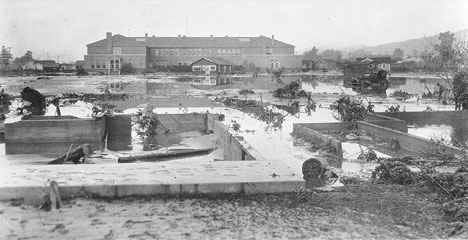A week after they were taken the two counties settled damage and death claims out of court but the photographs were kept on file.A recently discovered scrapbook of the life of Mexican opera star and humanitarian Elena de la Llata reveals the previously little-known accomplishments of La Cruz Azul Mexicana, The Mexican Blue Cross. They came to Santa Paula and other parts of the valley to give disaster relief. Sra. de la Llata was president of the group.Other heroes of the disaster include the “Hello Girls,” those brave switchboard operators who stayed at their post to warn their fellow citizens, knowing only that the wall of water was over 100 feet high when it left the dam.In a companion exhibit the Santa Paula Historical Society presents “Witness to a Disaster: Horrific Scenes and Heroic Acts”, photographic documentation portraying the human tragedy of the hapless victims and acts of human kindness and heroism during the disaster. The resilience of the community is also shown in the rebuilding and renewal of the devastated areas of town where the morning after the disaster some houses were found blocks from their foundations, if ever found at all. Included in the exhibit are dozens of photographs that have never been publicly displayed. The entire exhibit was selected from the Society’s extensive archived photo collection.Both exhibits are sure to fascinate with the wide range of vintage photographs of the tragic event and the history of the dam’s engineering and the geological factors that influenced the collapse.Located at 1001 E. Main St., the California Oil Museum is open Wednesdays through Sundays from 10 a.m. to 4 p.m. Admission is $2 for adults and $1 for children, free for museum members.For more information, call the California Oil Museum at 933-0076 or visit the COM Website at www.oilmuseum.net

|
Isbell Middle School is shown following theSt. Francis Dam collapse |
St. Francis Dam Disaster: Museum examines horrific collapse, aftermath
February 28, 2003
Santa Paula News
By Peggy Kelly
Santa Paula TimesIt’s odd how the state’s second largest disaster and the loss of at least 450 lives was almost forgotten, but on Sunday the California Oil Museum will revisit the events of the “St. Francis Dam Disaster - 75th Anniversary” with the opening reception for the exhibit that concentrates on the horrific collapse and its tragic aftermath.Minutes before midnight on the chilly evening of March 12, 1928 the St. Francis Dam’s 200-foot high concrete wall crumpled and collapsed, sending billions of gallons of raging flood waters down San Francisquito Canyon, about five miles northeast of what is now the city of Santa Clarita. The avalanche of water swept 54 miles down the Santa Clara River through the valley to the sea. No one knows the exact death toll but more than 450 people perished in the disaster. . .the bodies of victims were found as far away as the beaches of San Diego and some are still believed buried under the almost 20-foot thick layer of silt left behind.By the time the flood waters reached Santa Paula it was a semi-solid mass of churning water, trees, mud, buildings, bridges, vehicles, animals and human victims. Survivors of the disaster still live in Santa Paula and along the path of the 1928 destruction.This major exhibit, curated by John Nichols of the Sespe Group, will examine the full history of the disaster from the building of the dam to its unbelievable collapse and the horrific aftermath. Many inspiring stories of heroism in the face of disaster are told in the exhibit, which continues through August 17th.The opening of “St. Francis Dam Disaster - 75th Anniversary” is the first in a series of events to commemorate the tragedy which now, almost 75 years after it occurred, is again becoming the focus of attention.Two books on the disaster have been re-released and Nichols own photographic history “St. Francis Dam Disaster” was published late last year. A major documentary on the disaster is also being finalized.The exhibit will feature a large collection of vintage photographs of the disaster, and detailed engineering drawings will explain how the dam was built and why it collapsed. Both geology and engineering played important parts in the failure of the dam. In addition to the scenes of death and devastation the work of the rescue crews and the rebuilding of damaged homes is shown.Of special interest are the series of 5-foot long panoramic photographs taken by Ventura photographer Bernie Isensee to document the devastation. The Ventura County District Attorney foresaw the possibility of a lawsuit with Los Angeles County and commissioned them.


